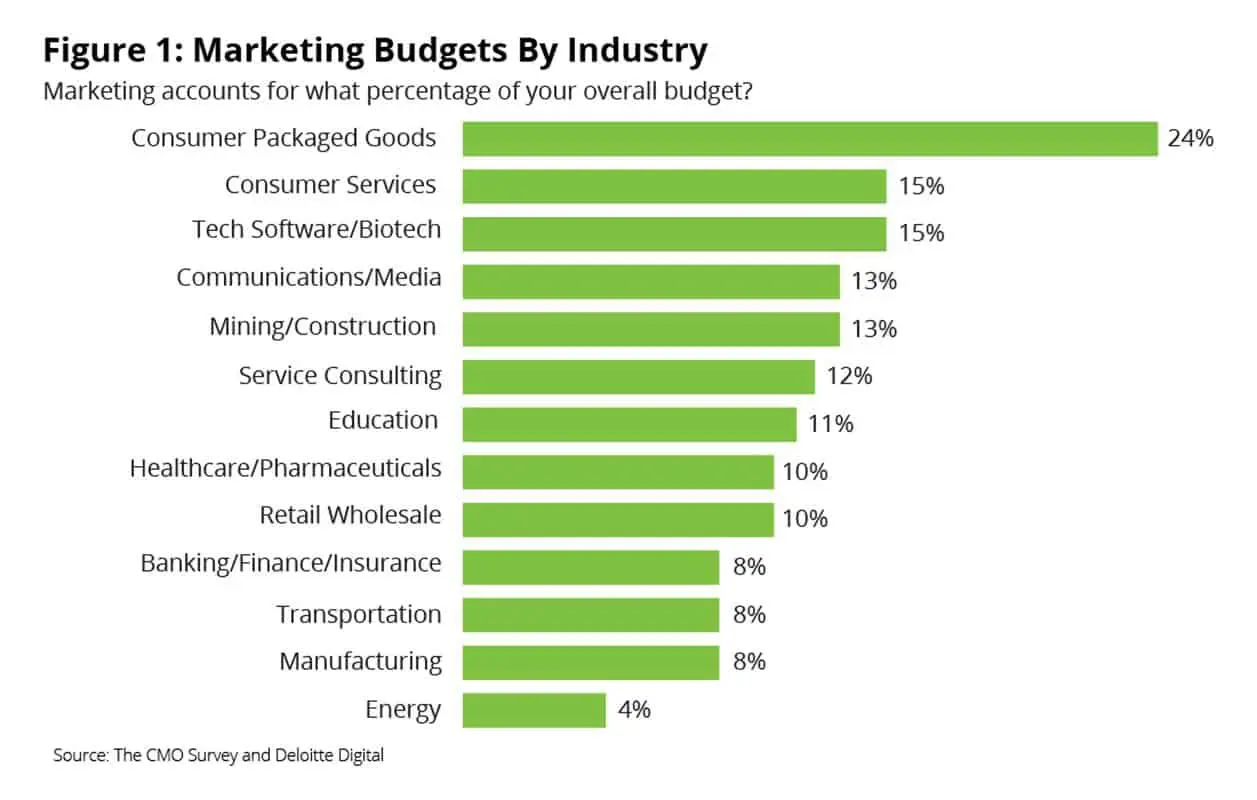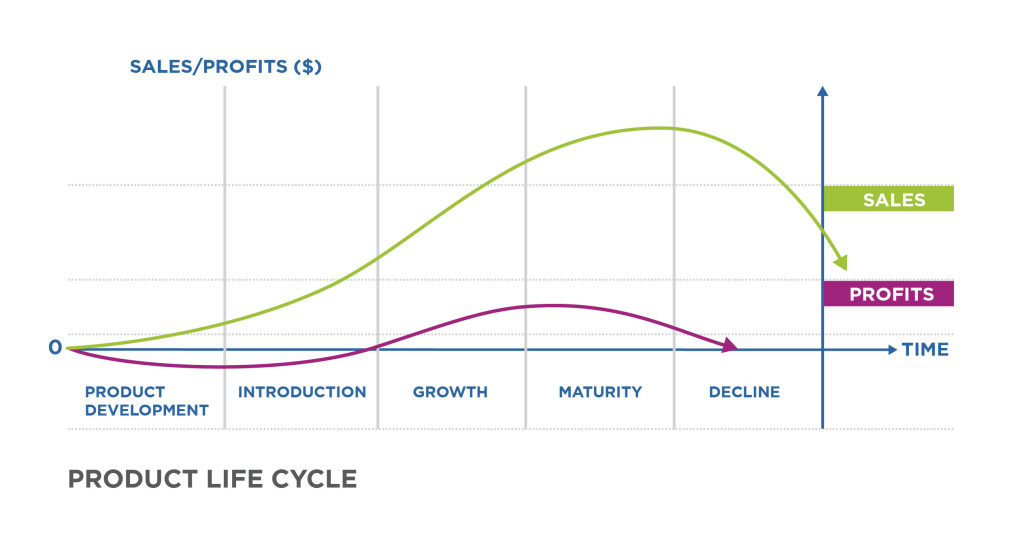A well-crafted marketing budget is an essential asset for businesses striving to attain their strategic objectives and optimize their return on investment.
Below, you can see the effective marketing budget (as a percentage of your overall budget) you need to allocate based on your industry.

For many businesses, especially SMEs (small and mid-sized enterprises), either don’t allocate sufficient funds to the marketing budget or they sweep away allocated funds at the first sign of trouble.
This is cutting off your nose to spite your face since the ONLY funds coming into a firm come from purchases. Expecting your firm to succeed based on borrowed or invested funds translates to failure in most situations.
Other factors, especially your phase in the business cycle, affect how much you must allocate as an effective marketing budget.
Recognizing the nuances of the business cycle is paramount in the formulation of a successful marketing budget, given that distinct stages necessitate tailored approaches.
In this article, we will delve into the essential factors for constructing an effective marketing budget that harmonizes with the diverse stages of the business cycle and can be adjusted to align with evolving business objectives.
In developing your initial marketing budget or adjusting your budget when you aren’t achieving your goals, a financial planner is a great asset.
The business cycle consists of five main stages: startup, expansion, peak, contraction, and trough. Each stage presents distinct challenges and opportunities that directly impact marketing strategies and budget allocations.
Thus, the image above only gives the average marketing budget as a percentage of your overall budget and doesn’t consider the demands imposed by your stage in the business cycle.
Effective marketing budget based on the business cycle
Startup phase
A crucial time in the lifecycle of your business is the startup phase.
Having worked as a consultant with the Nigeria Small Business Administration, I can tell you many startup owners walked in with an initial marketing budget approaching zero naira. That’s a recipe for disaster.
How can you expect to reach your target market to create awareness and compete with existing brands unless you spend some money? It’s like the old saying that you can’t make an omelet without cracking a few eggs.
So, how much should you allocate to marketing in your initial startup budget? Well, the answer is a little gnarly.
Some experts recommend you allocate 11.2% of your anticipated revenue as an initial marketing budget in the startup phase. Other experts offer differing amounts for an effective marketing budget.
Allocating an effective marketing budget is complicated by the product life cycle shown below. Not that profits don’t even start until well into the startup phase.

Thus, your revenue in this stage is likely very small, which means using a percentage of sales as the basis for budgeting results in too little money to move your brand to the next phase of development.
My advice is to spend as much as you can afford because you need to make a splash in the beginning if you hope to succeed.
I advise clients to consider the objective/ task method of budget allocation, which means allocating sufficient funds to meet their goals.
Expansion phase:
The expansion phase of the business cycle heralds a period of robust economic growth, translating into increased consumer spending.
Businesses operating in this favorable climate have a unique opportunity to leverage the positive economic conditions.
During this stage, companies often find it advantageous to allocate resources toward brand building, product launches, and market expansion.
Investing in these areas can yield substantial returns as consumers are more inclined to make purchases, making it an opportune time to establish a strong market presence and capitalize on emerging opportunities.
Peak phase:
As the business cycle reaches its peak, consumer demand tends to stabilize, signaling a potential plateau in economic growth.
During this phase, businesses should adopt a strategic approach to maintain their market share and optimize marketing efficiency.
It becomes crucial to focus on consolidating gains made during the expansion phase while preparing for potential economic slowdowns.
Strategic marketing efforts may involve refining product offerings, enhancing customer experiences, and exploring avenues for operational efficiency to ensure sustained success in a more stable market environment.
Contraction phase:
The contraction phase, marked by economic downturns, poses challenges as consumer spending typically contracts.
In such times, businesses must pivot their marketing strategies to weather the challenging economic conditions.
Prioritizing cost-effective marketing initiatives becomes imperative, with a heightened emphasis on customer retention strategies.
Targeted campaigns aimed at retaining existing customers and securing their loyalty can be instrumental in sustaining revenue streams during periods of reduced consumer confidence and spending.
Trough phase:
The trough phase represents the lowest point in the business cycle, characterized by diminished economic activity.
During this challenging period, businesses need to adopt conservative marketing approaches. While maintaining a visible market presence remains essential, careful expense management becomes paramount.
Companies may find it prudent to focus on essential marketing activities that uphold brand visibility without over-committing resources.
Strategic decisions, such as selective promotional efforts and efficiency-driven campaigns, become vital to navigate the trough phase successfully and position the business for recovery as the economy rebounds.
How to create an effective marketing budget
Set clear business goals:
Before embarking on the creation of a marketing budget, businesses must establish crystal-clear and measurable goals.
Whether the objective is to increase market share, boost sales, or enhance brand awareness, aligning the budget with these goals ensures that resources are strategically allocated for optimal outcomes.
Short-term vs. long-term goals:
Consideration of both short-term and long-term business objectives is essential when crafting a marketing budget.
Short-term goals may necessitate more immediate and tactical marketing efforts, such as promotions or time-bound campaigns, to generate quick results.
Conversely, long-term goals may require sustained investments in activities like brand building, customer loyalty programs, and market research to cultivate enduring success and customer loyalty over an extended period
Flexibility in budgeting:
Businesses should imbue their marketing budget with flexibility to adapt to unforeseen opportunities or challenges.
Building agility into budget planning allows for swift adjustments to capitalize on emerging trends or mitigate the impact of unexpected events.
This flexibility ensures that the marketing strategy remains dynamic and responsive to the evolving business landscape.
Regular review and adjustment:
Creating a marketing budget is an ongoing and dynamic process that requires continuous monitoring and adjustment.
Regular reviews enable businesses to stay responsive to changes in the business environment and shifts in consumer behavior.
This iterative approach ensures that the budget remains aligned with business goals and allows for real-time adjustments to optimize resource allocation.
Key Performance Indicators (KPIs):
Establishing relevant Key Performance Indicators (KPIs) is paramount to measuring the effectiveness of marketing initiatives.
Below, you can see how to determine what metrics are KPIs and what aren’t. We commonly call those elements that aren’t KPIs vanity metrics.

Regularly assessing these metrics provides valuable insights into the performance of various strategies and helps in making data-driven decisions.
Adjusting the budget based on KPI outcomes allows for a more efficient allocation of resources toward the most effective channels and campaigns.
Competitor analysis:
Keeping a close eye on competitor activities and market trends is crucial for maintaining a competitive edge.
Regularly assessing competitor strategies allows businesses to identify gaps or opportunities in the market.
Adjusting the marketing budget in response to competitive insights ensures that resources are strategically deployed to capitalize on emerging trends and outperform competitors.
Emerging technologies:
Embracing new technologies and marketing channels that align with the preferences of the target audience is vital for staying relevant.
Allocating resources to innovative strategies, such as social media campaigns, influencer marketing, or interactive content, can enhance a brand’s visibility and engagement.
Regularly reassessing the marketing budget to incorporate emerging technologies ensures that the business remains at the forefront of industry trends and effectively reaches its target audience.
Conclusion
Creating a marketing budget that aligns with the different stages of the business cycle and adapts to evolving business goals is a dynamic process.
By assessing the current economic climate, setting clear objectives, and regularly reviewing and adjusting the budget, businesses can navigate the complexities of the business cycle and ensure their marketing strategies remain effective and efficient.

